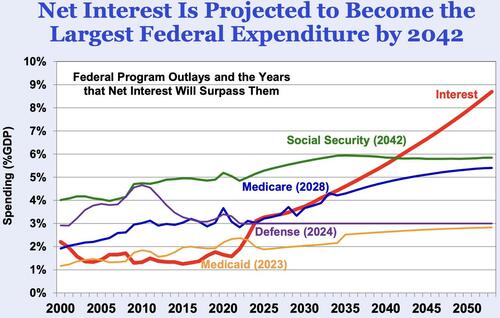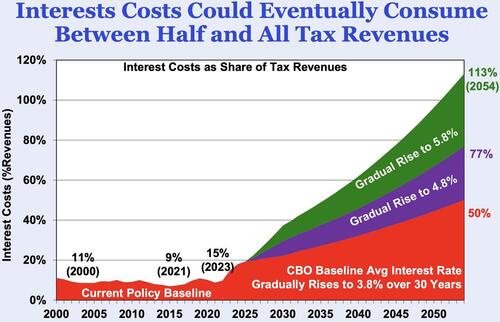
From Manhattan Institute’s Spending, Taxes & Deficits: A Book of Charts
Posted on 08/02/2025 8:49:33 PM PDT by SeekAndFind
When asked how far the US government has plunged into the red, many fiscally-conscious Americans will tell you the national debt has reached $37 trillion. As distressing as that official number is, America’s true fiscal situation is even worse — far worse. According to a barely-publicized Treasury report, the actual grand total of Uncle Sam’s obligations is more than $151 trillion.
That huge discrepancy springs from the fact that the federal government doesn’t hold itself to the same accounting standards it imposes on businesses. Rather than using accrual accounting — which recognizes expenses when they’re incurred — our Washington overlords self-servingly use simple cash accounting, only recognizing expenses when they’re paid. As a result, discourse on federal obligations solely focuses on the national debt, comprising Treasury bills, notes and bonds.
Once a year, however, an obscure report delivers a more accurate version of Uncle Sam’s balance sheet. While it receives almost no attention from journalists or public officials, the Treasury Department is required to submit an annual report to Congress detailing the government’s financial condition. Critically, the 1994 law compelling this report mandates that it reflect “unfunded liabilities” — that is, commitments made without any dedicated assets or income streams to ensure they’ll be kept.

One of the larger categories of those unfunded liabilities is future federal employee and veterans benefits. At the end of the 2024 fiscal year, this alone represented a $15 trillion obligation. However, by leaps and bounds, the largest unfunded liabilities spring from America’s social insurance obligations — primarily Social Security and Medicare. At fiscal-year end, these liabilities totaled a towering $105.8 trillion.
Stacking these and other unfunded liabilities on top of the publicly-held national debt and other obligations, you arrive at a grand total of $151.3 trillion at the end of the 2024 fiscal year. Offsetting that by an estimated $7.9 trillion in US government commercial assets — including property, plant, equipment and purported gold holdings — a Just Facts analysis puts Uncle Sam at an overall net-negative $143 trillion.
Writing at the Heartland Institute, Just Facts president James Agresti put that nearly-incomprehensible total in perspective: “$143 trillion amounts to 85% of the net wealth Americans have accumulated since the nation’s founding, estimated by the Federal Reserve to be $169 trillion. This includes all of their assets in savings, real estate, corporate stocks, private businesses, and even consumer durable goods like automobiles and furniture.”
Those numbers reflected the government’s position on Sept 30, 2024. They’ve not only grown significantly worse in the intervening months, they’re deteriorating at a blistering pace even as you read this: Not even counting the unfunded liabilities that represent the biggest part of the problem, the national debt alone is increasing at something like $156 million per hour.
Wrangling over the budget isn’t going to save us. Congressional debates tend to center on discretionary spending — outlays that require a vote by Congress during the appropriations process. However, America’s steady march to insolvency is driven by so-called mandatory spending, which is hardwired by previously-enacted laws.
In what may be the most ominous indication that the government is on an autopilot-course for catastrophe, the proportion of total federal outlays driven by mandatory spending has more than doubled since 1965 — from 34% to 73% in 2024. It was at 71% just two years earlier, in 2022.
From Manhattan Institute’s Spending, Taxes & Deficits: A Book of Charts
The two largest examples of mandatory spending are Social Security and Medicare. Those old-age programs are now well within sight of a crisis that’s been warned about for a generation: According to the latest report from their program trustees, Social Security and Medicare trust funds are now just seven years from insolvency.
While the federal government requires private-sector pension plans to maintain assets equal to the present value of future obligations, the federal government exempts itself from providing the same security to the citizens that it forces into the Social Security program. Contrary to the mythology that payroll taxes are placed in individual “accounts” held for our future benefit, that money is immediately being dished out to other people who’ve already reached the benefit-receiving phase — which is why Social Security can be reasonably compared to a Ponzi scheme.
Because the ratio of taxpaying-workers to beneficiaries is in steady decline — from 5.1 in 1960 to 2.7 in 2023 — Social Security payouts have exceeded revenues for the last 15 years. As a result, the Social Security and Medicare trust funds are set to run out in 2033. Under the law governing Social Security, payouts that year will be limited to program incomes — which will translate to a sudden 23% cut in payouts.
While that represents a political time bomb, don’t expect any urgency in defusing it. The eight-year countdown is short, but it’s still outside the next-election framing that drives elected officials’ actions. Those politicians know that anyone proposing a long-overdue rethinking of Social Security and Medicare will be opportunistically accused of “attacking” the programs. However, when the crisis is finally in their laps, don’t be surprised if part of their solution is to borrow money to prop up the payouts.
There’s another key component of mandatory spending that isn’t counted in the national debt: interest payments on debt issued to cover past and current spending. “In total, social programs and interest on the national debt—which mainly stems from social programs—account for 75% of all federal spending,” notes Agresti.
Interest payments also represent a steadily growing share of total outlays, and will total almost $1 trillion this year. Within 10 years, interest is projected to reach $2 trillion, roughly equal to the entire 2025 deficit. Last year saw a grim milestone, as interest expense surpassed spending on both defense and Medicare.
From Manhattan Institute’s Spending, Taxes & Deficits: A Book of Charts
Current projections have interest surpassing Social Security to become the largest single expenditure by 2042, but don’t be surprised if that milestone doesn’t come sooner. The government is already descending into a vicious cycle in which mounting US debt has the buyers of that debt demanding higher interest rates in compensation for the growing risk of inflation and/or default — with those higher rates creating larger interest payouts and even more debt.
Beyond mandatory-vs-discretionary, and funded-vs-unfunded, there’s an even more important but far-less-discussed classification of spending that goes to the very heart of America’s march toward financial disaster: constitutional vs unconstitutional. As I noted in the most-read article at Stark Realities, “Americans Are Fighting For Control Of Federal Powers That Shouldn’t Exist”:
Today’s sprawling federal government, which involves itself in almost every aspect of daily American life, is almost entirely unconstitutional.
To rattle off just a random fistful of the federal government’s unauthorized undertakings and entities — brace yourself — there is zero constitutional authority for the Social Security, Medicare, federal drug prohibitions, the Small Business Administration, crop subsidies, the Department of Labor, automotive fuel efficiency standards, climate regulations, the Federal Reserve, union regulation, housing subsidies, the Department of Agriculture, workplace regulations, the Department of Education, federal student loans, the Food and Drug Administration, food stamps, unemployment insurance or light bulb regulations. Even that sampling doesn’t begin to fully account for the scope of the unsanctioned activity.
This Pandora’s box of unconstitutional endeavors was opened wide by unconscionably expansive Supreme Court interpretations of the Constitution in the 1930s. It’s no coincidence that federal spending represented a mere 3% of GDP in 1930 but soared to an economy-warping 23% by 2024.
Now we find the federal government in a $143 trillion hole, a burden that comes out to $1,085,022 per US household. History suggests this will end with a government default. In the United States, that will likely occur not via an explicit repudiation of the debt, but through rampant price inflation as the Treasury and the Federal Reserve conspire to create new money out of thin air to make debt payments.
From Manhattan Institute’s Spending, Taxes & Deficits: A Book of Charts
“They can’t pay the debt, so they have to liquidate the debt,” said Ron Paul in a June conversation with David Lin. “They [won’t] default — they’re always going to pay something for the Treasury bills. What they’re going to do is liquidate the debt by paying it off with counterfeit money.”
While the Fed-Treasury money creation scheme has been with us for a long time, the alarming trajectory of federal debt and spending point to future money-printing on a scale that will trigger hyperinflation and economic collapse. At that point, Americans will stand at a crossroads. Desperation and fear will make them susceptible to the siren song of even more authoritarianism and unconstitutional, centralized command of the economy and society than what put them in such dire straits to begin with.
“People will want to be taken care of,” Paul said. “I see it as an opportunity. If people are promoting the cause of liberty and there’s chaos in the streets, we better get out there and lead the charge and say you don’t need more of what caused this. You don’t need more authoritarianism. What you need is more liberty and more peace, and that means you ought to obey the Constitution.”
Something doesn’t add up. I was told in 2012 by a member of congress that using GAAP, the feds were on the hook for North of 220 Trillion, at that time. The KungFlu sure must have cleaned up their obligations for them to be less than 200 Trillion now.
No problem. There is only one legal money printing machine in USA and the Feds have it. They can dispense gazillion worthless dollars.
Excellent information. People forget Ron Paul taught economics... He knows exactly what he is talking about and we should listen.
Off the books debt is 150 trillion.
This is all a bit shaky.
Money isn’t owed until it is borrowed. Explicitly borrowed.
If you promise future pension benefits, and then refuse to pay them, THAT IS NOT A DEFAULT.
Default is strictly and only the failure to make an interest payment on a loan, or retire a debt instrument when it matures.
Failure to pay benefits is not default. It’s ugly and there will be people who phrase it to equate failure to send money promised with interest on debt, but it is not that.
If the $150 trillion is a liability, then it is an asset for the people to whom it’s owed.
Therefore, you can increase the $169 trillion of assets by $150 trillion.
Bonds and foreign debt is explicit.
Owen is again, of course, part of the problem.
Where did all the money go?
Roads and bridges need fixing yet rarely do. Even the largest projects don’t make a dent in that $37 trillion + amount.
1 trillion is a number so large that no one can actually comprehend it. I would like to see a number that relates to the percentage of a person‘s income tax that goes to paying the national debt. If for example, a person pays $10,000 income tax and $3000 of it is simply going to pay interest on the debt, people would be more interested in reducing that debt. Does anyone know what that number is?
47 percent don’t pay taxes at all. That needs to change. I think until everyone pays something, they won’t understand or care about debt.
At the end of the day it really doesn’t matter that much. They’re like a family that makes $50,000 a year and Believe they have $10 million only to find out they owe a trillion dollars.
For family it all the Malaysians in bankruptcy. For a country, it only just ends up in war. The devil never be paid off. The important thing is that if they owe you money you get yours.
And that war will almost certainly be preceded by hyperinflation. Is may sound a little selfish but my one saving grace is that I’m old and will be dead before it happens or I’ll be sold when it does happen that I don’t care. Actually I already am. Nobody lives forever.
Have to million should be OWE ten million
One way to grasp its size is to make it small. That is imagine that 100 trillion dollars is the length of the football field. Now imagine how long a million dollars is. This is the way I do it.
That’s what really allows one to realize that this is utterly hopeless. It’s not a matter of if, but when. In fact I expected it to already have happened except I had no idea how far down the road they could continue kicking the can. But that end will come. And it’ll probably be preceded by ridiculous hyperinflation. Since they can always print their way out of it. The simple fact of the matter is a lot of people aren’t going to get the money they are owed. People, and organizations and countries. But that day could be a day off or 100 years off. Personally I can’t imagine going another 5 years.
And the post I just posted speaks to why I left Seattle for rural Kentucky acreage 14 years ago.
My retirement plan wasn’t to have a lot of money but to simplify my life. So I just made sure I was debt free so I don’t have to pay any taxes on my social security in my life is absurdly simple. Though stress is important when you’re old. 👍
I give up. My phone needs a hearing aid. I didn’t say anything about Malaysians. I got to quit speaking into the phone.
It is almost 40%.
https://www.foxbusiness.com/money/how-much-your-tax-money-goes-toward-servicing-us-national-debt.amp
That’s great. I’m almost debt free. About 48K left on my mortgage. I’m 56 so definitely will be debt free by 67. I do have to build the net egg a bit more. If the United States stays solvent, we should have a nice retirement. Unfortunately, a lot of it isn’t in our hands but the crazy government.
Wow! 40%. That is a number that each taxpayer can wrap her head around. Those of us who pay off our credit cards every month cannot imagine spending money we do not have on non- essentials that would require us pay interest every month.
Politicians are devious to us in so many ways.
Disclaimer: Opinions posted on Free Republic are those of the individual posters and do not necessarily represent the opinion of Free Republic or its management. All materials posted herein are protected by copyright law and the exemption for fair use of copyrighted works.